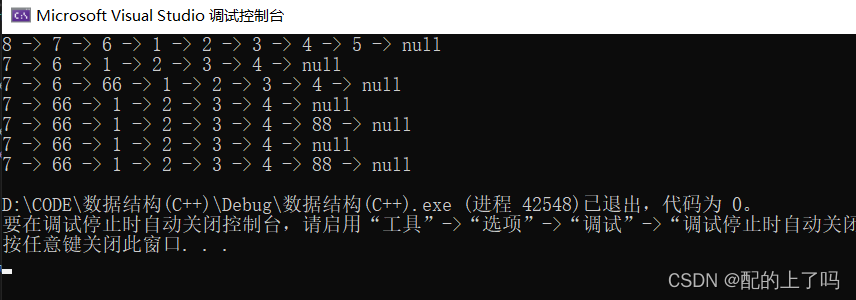C++实现单链表
SList.h
#include<iostream>
#include<assert.h>
using namespace std;
typedef int DataType;
struct Node
{
DataType data;
struct Node* next;
};
class SList
{
public:
SList() :head(nullptr) {}
SList(const SList& sl) { head = copySList(sl); }
SList& operator=(const SList& sl)
{
Node* p = copySList(sl);
free();
head = p;
return *this;
}
~SList() { free(); }
public:
void push_back(const DataType&);
void push_front(const DataType&);
void pop_back();
void pop_front();
void print()const;
Node* find(const DataType&); // 以某值为索引,查找某节点
void insert(Node* p, const DataType&); // 在p结点之后插入一个值
void erase(Node* p); // 删除p结点
private:
Node* head;
void free()
{
while (head != nullptr)
{
Node* next = head->next;
delete head;
head = next;
}
head = nullptr;
}
Node* copySList(const SList& sl)
{
//SList newsl;
//Node* cur = sl.head;
//while (cur != NULL)
//{
// newsl.push_back(cur->data);
// cur = cur->next;
//}
//return newsl.head;
Node ret{ 0,NULL };
Node* node = &ret;
Node* cur = sl.head;
while (cur != NULL)
{
Node* tmp = new Node{ cur->data,NULL };
node->next = tmp;
node = node->next;
cur = cur->next;
}
return ret.next;
}
Node* CreatNode(const DataType& x)
{
Node* newnode = new Node{ x, nullptr };
//newnode->data = x;
//newnode->next = nullptr;
return newnode;
}
};SList.cpp
#include"SList.h"
void SList::push_back(const DataType& x)
{
Node* newnode = CreatNode(x);
if (head == nullptr)
{
head = newnode;
return;
}
Node* cur = head;
while (cur->next != nullptr)
{
cur = cur->next;
}
cur->next = newnode;
}
void SList::push_front(const DataType& x)
{
Node* newnode = CreatNode(x);
newnode->next = head;
head = newnode;
}
void SList::pop_back()
{
assert(head);
if (head->next == nullptr)
{
delete head;
head = nullptr;
}
else
{
Node* cur = head;
while (cur->next->next != nullptr)
{
cur = cur->next;
}
delete cur->next;
cur->next = nullptr;
}
}
void SList::pop_front()
{
Node* tmp = head;
head = head->next;
delete tmp;
}
void SList::print()const
{
if (head == nullptr)
cout << "null" << endl;
else
{
Node* cur = head;
while (cur != nullptr)
{
cout << cur->data << " -> ";
cur = cur->next;
}
cout << "null" << endl;
}
}
Node* SList::find(const DataType& x) // 以某值为索引,查找某节点
{
assert(head);
Node* cur = head;
while (cur != nullptr)
{
if (cur->data == x)
return cur;
cur = cur->next;
}
return nullptr;
}
void SList::insert(Node* p, const DataType& x)
{
Node* newnode = CreatNode(x);
assert(p);
newnode->next = p->next;
p->next = newnode;
}
void SList::erase(Node* p)
{
assert(p);
if (head == p)
{
Node* tmp = head->next;
delete head;
head = tmp;
}
{
Node* cur = head;
while (cur->next != p)
{
cur = cur->next;
}
cur->next = cur->next->next;
delete p;
}
}
测试
void test()
{
SList sl1;
sl1.push_back(1);
sl1.push_back(2);
sl1.push_back(3);
sl1.push_back(4);
sl1.push_back(5);
sl1.push_front(6);
sl1.push_front(7);
sl1.push_front(8);
sl1.print();
sl1.pop_back();
sl1.pop_front();
sl1.print();
sl1.insert(sl1.find(6), 66);
sl1.print();
sl1.erase(sl1.find(6));
sl1.print();
SList sl2(sl1);
sl2.push_back(88);
sl2.print();
sl1.print();
sl1 = sl2;
sl1.print();
}
int main()
{
test();
return 0;
}
代码评价:
比较好的是私有成员函数copySList的建立,可以辅助建立拷贝构造函数和拷贝赋值运算符。
作用就是再拷贝一份相同的链表,并返回新建链表的头结点,需要自定义拷贝成员的原因是链表的建立需要开辟动态内存,且是类值的,不能进行浅拷贝和默认析构。
因为此单链表无头结点,所以在尾插尾删等处需要分情况进行讨论。
单链表:
单链表相比于顺序表并没有明显的进步:单链表头插头删效率高,但是尾插尾删仍是O(N),且中间元素的删除插入也是O(N),并且不支持顺序表的随机访问。
一个小的进步就是单链表按需存储释放空间。
无头单向非循环链表:结构简单,一般不会单独用来存数据。实际中更多是作为其他数据结 构的子结构,如哈希桶、图的邻接表等等。另外这种结构在笔试面试中出现很多。
顺便给出C语言实现的单链表
SList.h
#pragma once
#include<stdio.h>
#include<stdlib.h>
#include<assert.h>
typedef int SListDataType; //typedef需要分号结尾
typedef struct SListNode
{
SListDataType data; //数据
struct SListNode* next; //下一个节点的地址
}SListNode;
// 创建一个节点
SListNode* CreatSLTNode(SListDataType x);
// 打印一个链表,传入头节点,因为不会更改,所以传一维指针即可。
void PrintSList(SListNode* pnode);
// 尾插
void SListPushBack(SListNode** pphead, SListDataType x);
// 头插
void SListPushFront(SListNode** pphead, SListDataType x);
// 尾删
void SListPopBack(SListNode** pphead);
// 头删
void SListPopFront(SListNode** pphead);
// 查找某节点
SListNode* SListFind(SListNode* phead, SListDataType x);
// 单链表在pos位置之后插入x
void SListInsertAfter(SListNode* pos, SListDataType x);
// 单链表删除pos位置之后的值
void SListEraseAfter(SListNode* pos);
//链表的销毁
void SListDestroy(SListNode** phead);SList.c
#include"SList.h" //单链表
SListNode* CreatSLTNode(SListDataType x)
{
SListNode* newnode = (SListNode*)malloc(sizeof(SListNode));
assert(newnode);
newnode->data = x;
newnode->next = NULL;
return newnode; //newnode是那个新的节点的地址,内容已经初始化,next为NULL。
}
void PrintSList(SListNode* phead)
{
SListNode* cur = phead;
while (cur != NULL)
{
printf("%d->", cur->data);
cur = cur->next;
}
printf("NULL\n");
}
void SListPushBack(SListNode** phead, SListDataType x) //phead是头节点地址的地址,*phead即那个节点的指针。
{
SListNode* newnode = CreatSLTNode(x);
if (*phead == NULL)
*phead = newnode;
else
{
SListNode* cur = *phead;
while (cur->next != NULL)
{
cur = cur->next;
}
(*cur).next = newnode;
//cur->next = newnode;
}
}
void SListPushFront(SListNode** pphead, SListDataType x)
{
SListNode* newnode = CreatSLTNode(x);
newnode->next = *pphead;
*pphead = newnode; //一维指针的地址进行解引用。
}
void SListPopBack(SListNode** pphead)
{
//尾删
assert(*pphead); //防止这是一个空链表
if ((*pphead)->next == NULL)
{
free(*pphead);
*pphead = NULL;
}
else
{
SListNode* cur = *pphead;
while (cur->next->next != NULL)
{
cur = cur->next;
}
free(cur->next);
cur->next = NULL;
//SLTNode* tail = *pphead;
//SLTNode* Pretail = NULL;
//while (tail->next != NULL)
//{
// Pretail = tail;
// tail = tail->next;
//}
//free(tail);
//Pretail->next = NULL;
}
}
void SListPopFront(SListNode** pphead)
{
assert(*pphead); //断言头节点的指针不为空
//SListNode* tmp = (*pphead)->next;
//free(*pphead);
//*pphead = tmp;
SListNode* tmp = *pphead;
*pphead = (*pphead)->next;
free(tmp);
}
SListNode* SListFind(SListNode* phead, SListDataType x)
{
assert(phead); //如果这个结构体指针为空,表明这是一个空链表。
SListNode* cur = phead;//则这个结构体指针不为空,只少有一个节点。
while (cur)
{
if (cur->data == x)
return cur;
cur = cur->next;
}
return NULL;
}
void SListInsertAfter(SListNode* pos, SListDataType x)
{
assert(pos);
SListNode* newnode = CreatSLTNode(x);
newnode->next = pos->next;
pos->next = newnode;
}
void SListEraseAfter(SListNode* pos)
{
assert(pos);
if(!pos->next) //如果这个是最后一个节点,什么也不做
{
return;
}
else
{
SListNode* tmp = pos->next;
pos->next = pos->next->next;
free(tmp);
tmp = NULL;
}
}
void SListDestroy(SListNode** phead)
{
assert(*phead); //
SListNode* cur = *phead, *next = (*phead)->next;
while (cur)
{
next = cur->next;
free(cur);
cur = next;
}
*phead = NULL;
}作用可能就是可以加深对指针的理解吧。需要修改结构体,则需要传指向结构体的指针,需要修改一级指针,则需要传指向一级指针的指针:即二级指针。因为此单链表无头结点,所以若空链表情况下进行尾插,则需要修改指向链表第一个结点的指针,所以头插尾插头删尾删需要传二级指针。





















 5002
5002











 被折叠的 条评论
为什么被折叠?
被折叠的 条评论
为什么被折叠?








